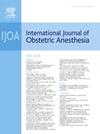一项回顾性队列研究(2013-2022):在产科队列中,轴向手术和时间对产后下肢感觉运动障碍的识别
IF 2.3
3区 医学
Q2 ANESTHESIOLOGY
引用次数: 0
摘要
前言:产科患者轴向麻醉后周围神经损伤是罕见的,但会影响产后恢复。不同分娩方式的麻醉需求可能影响阻滞密度和神经缺陷识别的时间。我们假设,产后下肢神经功能障碍的识别时间会因分娩方式的不同而有显著差异。方法:我们进行了一项为期9年(2013-2022)的回顾性队列研究,确定了因神经轴向手术后下肢感觉运动障碍而转诊到麻醉科和/或产科内科就诊的产后患者。主要观察指标是首次发现神经功能障碍的时间,并按分娩方式分层。次要结局包括发生率、活动时间、住院时间和周围神经损伤亚型分层的恢复情况。时间数据组间比较采用单因素方差分析和事后两两比较校正多重比较。所有其他结果采用描述性统计进行分析。结果在61,044例分娩和43,861例神经轴手术中,发现74例产后周围神经病变,发生率为0.17%(1 / 588)。最常见的诊断为腰骶神经丛病(37.8%)、股神经病变(33.7%)和股外侧皮神经病变(16.2%)。首次发现产后缺陷的平均±标准差时间为22.9±18.7小时,分娩后首次下床的平均时间为22.1±18.3小时。与自然阴道分娩相比,产时剖宫产明显延迟了识别时间(33.6小时vs 15.9小时;P = 0.005)。92%的患者只需要一次或两次门诊随访。从门诊随访到出院的中位时间为29天。产后周围神经损伤是罕见的,当它们发生时,通常与良好的恢复有关。下肢神经功能缺陷的识别在产时剖宫产后延迟。结构化的产后神经轴阻滞监测,结合鼓励早期活动和患者自我报告工具的举措,可能有助于及时诊断、患者咨询和管理。本文章由计算机程序翻译,如有差异,请以英文原文为准。
Neuraxial procedures and time to recognition of postpartum lower limb sensorimotor deficit in an obstetric cohort: a retrospective cohort study (2013–2022)
Introduction
Peripheral nerve injuries after neuraxial anesthesia in obstetric patients are rare but can impact postpartum recovery. The anesthetic requirements for different modes of delivery may influence block density and the timing of neurologic deficit recognition. We hypothesized that the time to recognition of postpartum lower limb neurologic deficits would differ significantly by mode of delivery.
Methods
We conducted a retrospective cohort study over a 9-year period (2013–2022), identifying postpartum patients referred to anesthesiology and/or obstetric internal medicine consultation for lower limb sensorimotor deficit following neuraxial procedure. The primary outcome was time to first recognition of neurologic deficit, stratified by mode of delivery. Secondary outcomes included incidence, time to ambulation, duration of hospitalization, and recovery profile stratified by peripheral nerve injury subtype. Time data were compared between groups using one-way analysis of variance and post hoc pairwise comparisons adjusted for multiple comparisons. All other outcomes were analyzed using descriptive statistics.
Results
Among 61,044 deliveries and 43,861 neuraxial procedures, 74 cases of postpartum peripheral neuropathies were identified, yielding an incidence of 0.17% (1 in 588). The most common diagnoses were lumbosacral plexopathy (37.8%), femoral neuropathy (33.7%), and lateral femoral cutaneous neuropathy (16.2%). Mean ± standard deviation time to first recognition of postpartum deficit was 22.9 ± 18.7 hours, and mean time to first ambulation after delivery was 22.1 ± 18.3 hours. Significantly delayed recognition occurred after intrapartum cesarean compared with spontaneous vaginal delivery (33.6 vs. 15.9 hours; P=0.005). For 92% of patients, only one or two outpatient follow-up visits were needed. The median time to discharge from outpatient follow-up was 29 days.
Discussion
Postpartum peripheral nerve injuries following neuraxial anesthesia are uncommon and, when they occur, are most often associated with favorable recovery. Recognition of lower limb neurologic deficits was most delayed following intrapartum cesarean deliveries. Structured postpartum neuraxial block monitoring, combined with initiatives that encourage early ambulation and patient self-reporting tools may support timely diagnosis, patient counselling and management.
求助全文
通过发布文献求助,成功后即可免费获取论文全文。
去求助
来源期刊
CiteScore
4.70
自引率
7.10%
发文量
285
审稿时长
58 days
期刊介绍:
The International Journal of Obstetric Anesthesia is the only journal publishing original articles devoted exclusively to obstetric anesthesia and bringing together all three of its principal components; anesthesia care for operative delivery and the perioperative period, pain relief in labour and care of the critically ill obstetric patient.
• Original research (both clinical and laboratory), short reports and case reports will be considered.
• The journal also publishes invited review articles and debates on topical and controversial subjects in the area of obstetric anesthesia.
• Articles on related topics such as perinatal physiology and pharmacology and all subjects of importance to obstetric anaesthetists/anesthesiologists are also welcome.
The journal is peer-reviewed by international experts. Scholarship is stressed to include the focus on discovery, application of knowledge across fields, and informing the medical community. Through the peer-review process, we hope to attest to the quality of scholarships and guide the Journal to extend and transform knowledge in this important and expanding area.

 求助内容:
求助内容: 应助结果提醒方式:
应助结果提醒方式:


